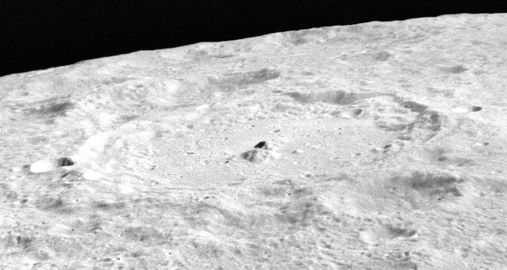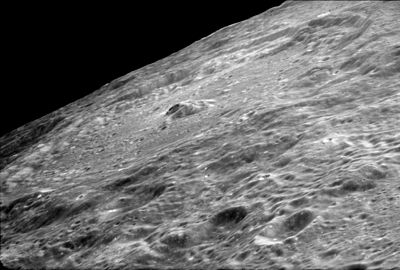Sklodowska (lunar crater)
 LRO image | |
| Coordinates | 18°12′S 95°30′E / 18.2°S 95.5°E |
|---|---|
| Diameter | 127 km |
| Depth | Unknown |
| Colongitude | 266° at sunrise |
| Eponym | Maria S. Curie |
Sklodowska (Skłodowska) is a large lunar impact crater that is located on the far side of the Moon. It lies just past the southeastern limb, and can sometimes be viewed from Earth under favorable conditions of libration and illumination. The crater is located to the northeast of the older walled plain Curie, and to the southwest of Pasteur, another walled plain.
This is a prominent crater with a well-defined rim and little appearance of wear from impact erosion. The edge forms a rough circle, but it is irregular with a number of small outward bulges, particularly to the south and southwest. The small crater Sklodowska J intrudes slightly into the southeastern rim.
The inner walls have a system of multiple terraces, and there are some slumped shelves along the northeastern side. The inner wall is somewhat narrower along the north and wider to the south and northeast. Within the crater the interior floor is a nearly level plain that is marked by a number of small craterlets. There is a prominent central peak formation at the crater midpoint, which consists of two ridges separated by a narrow valley. The larger of the two peaks lies to the northeast of the center, while the smaller is to the southwest.
This crater gained its title from the birth name of Maria Skłodowska-Curie, the Polish-born French scientist.
Views[edit]
-
View from Apollo 15
-
Oblique view from Apollo 15
-
Oblique view from Apollo 16
-
Oblique view facing southwest, from Apollo 17
Satellite craters[edit]
By convention these features are identified on lunar maps by placing the letter on the side of the crater midpoint that is closest to Sklodowska.
| Sklodowska | Latitude | Longitude | Diameter |
|---|---|---|---|
| A | 14.7° S | 96.5° E | 44 km |
| D | 13.7° S | 99.0° E | 16 km |
| J | 19.3° S | 97.7° E | 16 km |
| R | 18.9° S | 92.2° E | 17 km |
| Y | 13.2° S | 95.4° E | 17 km |
References[edit]
- Andersson, L. E.; Whitaker, E. A. (1982). NASA Catalogue of Lunar Nomenclature. NASA RP-1097.
- Blue, Jennifer (July 25, 2007). "Gazetteer of Planetary Nomenclature". USGS. Retrieved 2007-08-05.
- Bussey, B.; Spudis, P. (2004). The Clementine Atlas of the Moon. New York: Cambridge University Press. ISBN 978-0-521-81528-4.
- Cocks, Elijah E.; Cocks, Josiah C. (1995). Who's Who on the Moon: A Biographical Dictionary of Lunar Nomenclature. Tudor Publishers. ISBN 978-0-936389-27-1.
- McDowell, Jonathan (July 15, 2007). "Lunar Nomenclature". Jonathan's Space Report. Retrieved 2007-10-24.
- Menzel, D. H.; Minnaert, M.; Levin, B.; Dollfus, A.; Bell, B. (1971). "Report on Lunar Nomenclature by the Working Group of Commission 17 of the IAU". Space Science Reviews. 12 (2): 136–186. Bibcode:1971SSRv...12..136M. doi:10.1007/BF00171763. S2CID 122125855.
- Moore, Patrick (2001). On the Moon. Sterling Publishing Co. ISBN 978-0-304-35469-6.
- Price, Fred W. (1988). The Moon Observer's Handbook. Cambridge University Press. ISBN 978-0-521-33500-3.
- Rükl, Antonín (1990). Atlas of the Moon. Kalmbach Books. ISBN 978-0-913135-17-4.
- Webb, Rev. T. W. (1962). Celestial Objects for Common Telescopes (6th revised ed.). Dover. ISBN 978-0-486-20917-3.
- Whitaker, Ewen A. (1999). Mapping and Naming the Moon. Cambridge University Press. ISBN 978-0-521-62248-6.
- Wlasuk, Peter T. (2000). Observing the Moon. Springer. ISBN 978-1-85233-193-1.
External links[edit]
L&PI topographic maps of crater:




